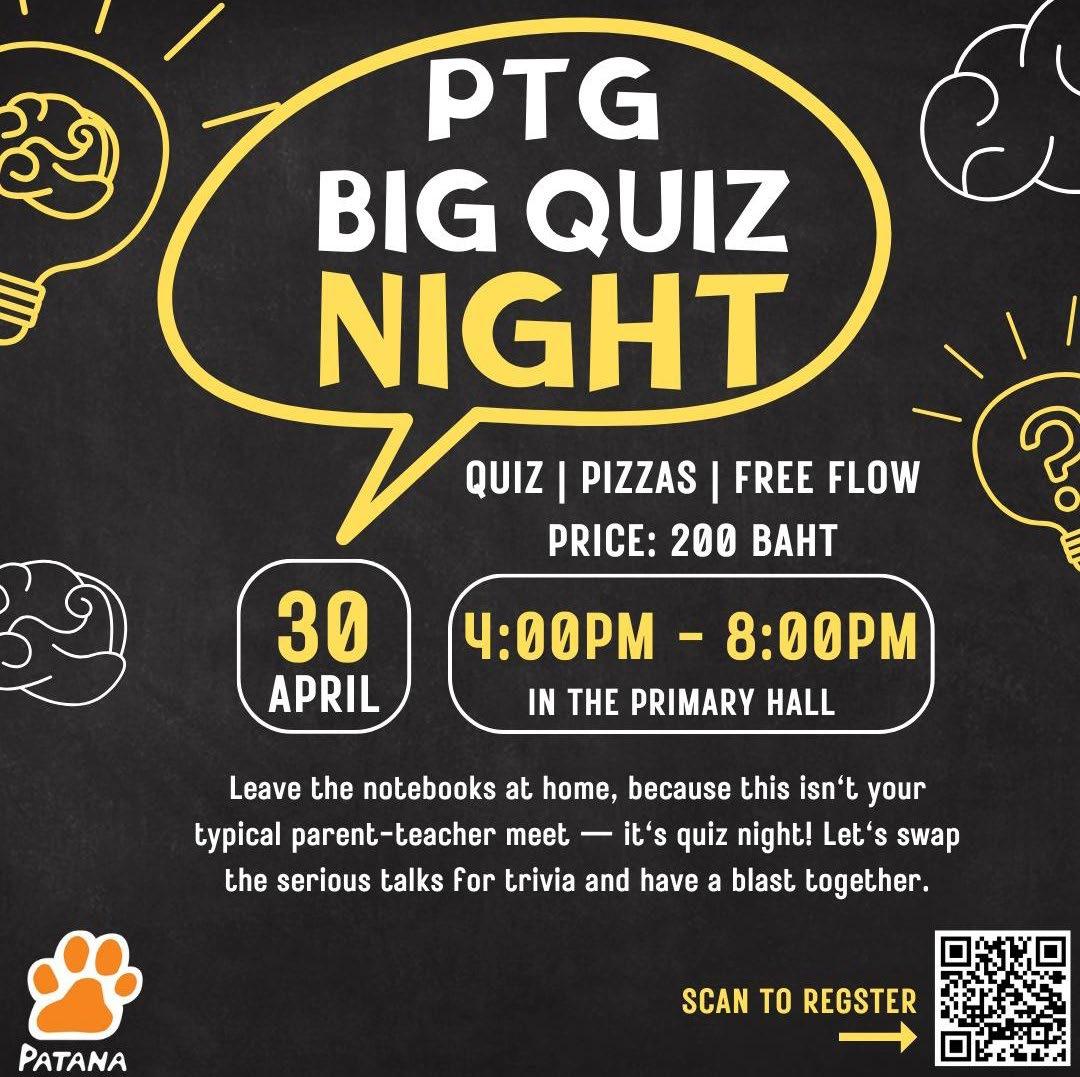






In every corner of our school, there are untold stories of potential just waiting to be discovered. Our school, like many others, is brimming with this hidden treasure. Recently, I’ve been particularly moved by Adam Grant’s ‘Hidden Potential - The Science of Achieving Greater Things’ a read that has shifted my perspective on our educational endeavours. Grant’s exploration into the unexpected sources of extraordinary potential echoes my own beliefs about the vast capabilities within our school community. Reading his book, one idea struck a chord with me: “The most impactful people are often those who, in the eyes of the world, are just ordinary. But in their actions, they cultivate extraordinary potential.” This insight serves as a powerful reminder of the latent abilities within each student, teacher, and staff member, all quietly waiting for the right moment or the right encouragement to emerge and dazzle.
Our school should be a place where mistakes are not just forgiven but are seen as essential to learning. I believe in
creating spaces alive with curiosity, where students are encouraged to follow their passions, even down unconventional paths. It’s about celebrating the potential in varied forms, beyond just grades and accolades.
I cannot stress enough how diversity and inclusivity are the bedrock of uncovering potential. When we weave these values into the fabric of our schools, we create a tapestry rich with possibilities. It’s about ensuring every single person in our school community feels seen, heard, and valued, setting the stage for them to unveil their unique talents and perspectives.
The transformative impact of mentorship and coaching cannot be overstated. It’s not merely about guiding academically but illuminating paths for personal growth, confidence, and curiosity. As mentors and coaches, we

don’t just share knowledge; we share journeys, offering support, encouragement, and sometimes, a new perspective. This dual approach not only helps in navigating academic challenges but also in developing life skills that transcend the classroom.
Actively seeking and nurturing potential requires us to sometimes be detectives, looking for clues in the unlikeliest of places. It’s about creating opportunities for every student to showcase their talents, be it through art shows, science fairs, or storytelling sessions. It’s a commitment to dig deeper, beyond the surface, to discover the brilliance within each individual..
There’s a profound transformation that occurs when someone feels genuinely supported and believed in. This belief can ignite a fire within, driving individuals to engage, innovate, and contribute in ways they never
thought possible. It’s this empowerment that turns our schools into vibrant ecosystems of creativity and growth.
To all our students and colleagues: let’s persist in our vigilance for the incredible potential among us, striving to craft an environment where each talent is recognised and celebrated. For a dose of inspiration, I strongly recommend diving into Adam Grant’s video, ‘Adam Grant’s #1 phrase to unlock potential.’ It offers valuable insights into uncovering and nurturing the hidden potential that surrounds us.
Looking forward, my optimism is bolstered by the strides we’ve already made, inspired by insights from thought leaders like Adam Grant. Our school is on a continuous path of growth, leveraging the strong foundation we’ve established in inclusivity, support, and empowerment. It’s about gently turning up the volume on what we’re already doing, and fine-tuning our environment to further foster innovation, collaboration, and a profound sense of achievement and contentment.
“The most impactful people are often those who, in the eyes of the world, are just ordinary. But in their actions, they cultivate extraordinary potential.”- Adam Grant

In Year 4, we are committed to nurturing not only our students’ academic achievement, but also the vital skills and characteristics that children need to become effective, life-long learners. Independence in childhood develops confidence, motivation and perseverance in school. It offers children a sense of control over their lives and fosters self-reliance. We recognise that when children have a say in what is going on around them, and a sense of responsibility, they start to develop the belief that their ideas and opinions matter and that they are capable and competent.
An independent learner is one who can take responsibility for, and lead their own learning. In Year 4, we aim to develop children to take the initiative, seek answers and problem solve without relying solely on the teacher. Developing independent learners is important to help students advance in their academic performance, take pride in their learning and stay motivated and engaged.
Built into the final weeks of each of our termly themes, is the opportunity for our students to develop their learning further using the skills and knowledge they have acquired during the unit. Project Based Learning encourages students to choose an area of our theme that they are particularly interested in and would like to know
more about. They work alongside others to investigate, collaborate, and produce meaningful projects, based on new learning, making changes or trying new strategies to solve problems. During these sessions, the teacher is the facilitator, offering guidance and feedback whilst the student is the main driver of the project. This introduces children to critical thinking, tolerance, perseverance, and teamwork skills while igniting their curiosity and passion for learning.
Residential trips are an excellent way for children to develop their independence, confidence and ability to navigate the world, away from the comfort of home and their families.
During our Year 4 trip to Hua Hin, children were encouraged to take responsibility for several parts of their day. Gentle reminders and guidance from the adults on the trip empowered children to navigate the shared responsibility of keeping their rooms clean and tidy in order to avoid the unpleasant smell of a damp towel left on the floor after a shower, or the loss of a favourite t-shirt that has ended up in somebody else’s bag. So, when it was time for room inspections, the sense of pride the children


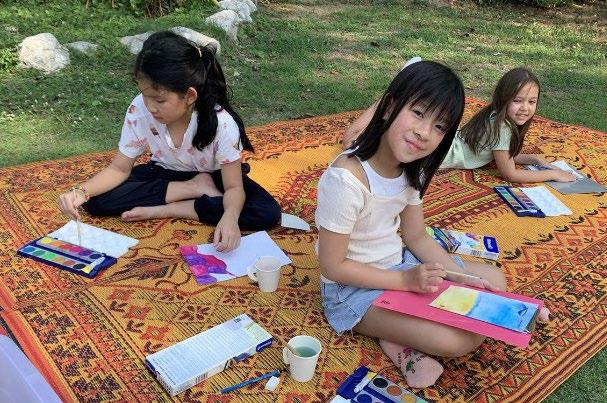

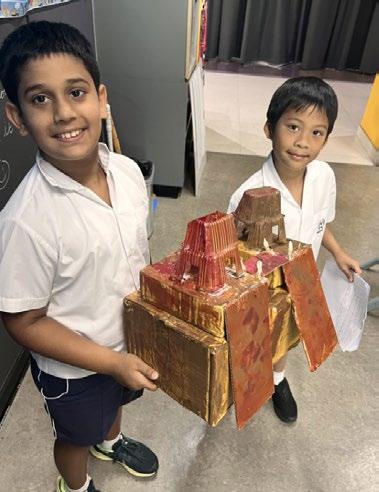
felt in having managed their environment themselves was wonderful to witness.
Independently packing their own bags, before a visit to the water park, developed our students’ organisational skills and self-reliance. Having the room to make mistakes in a safe environment and taking accountability for their own belongings builds self-esteem and self-sufficiency.
All friendships have problems from time to time and all children will experience the turmoil of an argument or falling out with a friend. Through regular PSHE lessons, we aim to share with our students that getting along with others is something that we all have to work on; navigating
friendships can be difficult, but with the right strategies we can find compromise and move on. Learning to solve problems peacefully and with independence fosters empathy and an understanding of other points of view.
Year 4 children are given the opportunity to role play scenarios and discuss the steps they can take to help them resolve conflict. Our teachers model conversations, make suggestions on how to remain calm when friendships become tricky and guide children to find a compromise so that everybody feels heard and understood. Of course, our children often need support to follow these steps and our teachers are always happy to mediate and guide children in their conversations; with the children in the driving seat!
On Tuesday 5th March, our Year 10 Resistant Materials students who have recently commenced their IGCSE project- designing a lighting product, visited IKEA at Mega Bangna with the purpose of conducting primary research. Students conducted an in-depth study of lights with different applications, collected information and looked at a wide range of lighting products, many of which were displayed in domestic home settings. Students also looked at fixtures and fittings, bulbs, power sources, switches, etc.
As educators we feel IKEA is an example of good design. The benefit of the visit was that students were able to see well designed domestic products and interiors. Students collected information regarding lighting components and fixtures and fittings in addition to looking at how lights are manufactured and assembled.
We have no doubt that our students will be truly inspired by what they have seen and be more able to contextualise the value of good lighting design. Hopefully this will help generate innovative design ideas and develop knowledge and understanding for theoretical work. Below are some reflections from students about the trip.
Lauren Kim (10O): “The Year 10 DT RM trip to IKEA was very beneficial and insightful for all the students. It offered a diverse array of product examples, materials, and patterns which gave us a great deal of inspiration for our own personal projects. The opportunity to explore various environments and settings within IKEA provided valuable insights into different types of lighting situations and their applications. I think everyone can agree that they found the
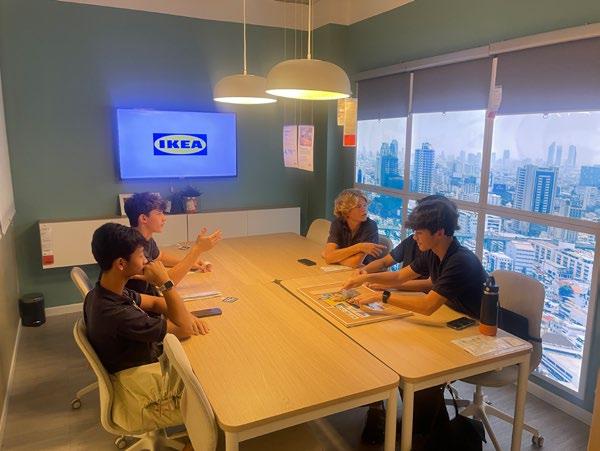
interactive nature of this trip very enjoyable, and it helped us to envision how different lamps could enhance different environments. This trip was important to us as DT students because it provided a hands-on experience. The freedom of being able to walk through IKEA independently allowed us to explore ideas at our own pace. This gave us lots of time to fully analyse and think about the different elements we wanted to include in our lighting solutions. From examining joints, switches, and different materials, to studying different shapes of bulbs with varying colours. We gained practical knowledge that helped enhance our product design and development. In summary, the IKEA trip was an eye-opening experience which offered us lots of inspiration, ideas, and real-life applications for our upcoming projects. We broadened our perspectives on the different styles and possibilities for our lamps, gaining valuable new knowledge that would shape our final products and client satisfaction.”
Penelope Dever (10V): “I liked looking at how the different joints and materials slot together, which is helpful for planning my lamp. There were also different boxes that had different shapes of bulbs with different colours of light which is helpful for writing my product performance writing.”
Richie Wang (10M): “I found this trip helpful and interesting because I was able to go around and see all the different types of lamps, switches, and bulbs. It gave me more ideas on how I should style, colour and the material of my lamp. This trip gave me a variety of ideas and gave me inspiration.”
Raphael Schulzinger (10M): “The experience at Ikea was a memorable one not only helping me develop my own ideas but helping me to understand the ideas of others as well. As well as that analysing the different marketing techniques and average price ranges of the Ikea products was very useful and productive.”
Violet Stephan (10O): “This trip was a fantastic way to explore the commercial world of lamp manufacturing, as well as get an idea of how businesses size and price their products. It was very useful to be able to evaluate and interact with the wide range of designs and discuss with classmates. With many photographs and notes, I now feel more confident in entering the new period of designing lamp ideas.”
Oliver Somanatha Arachchige (100): “This trip helped

me because it really boosted my knowledge from 25% knowledge on lightbulbs to 100%. As we can see this is a beneficial increase which is why I believe that this trip is one that will suffice my DT knowledge so I can make sure my grades are top notch. I also really liked the aspect of being independent and having to use my own thinking skills to gain this knowledge which I think highlights how this trip was a real success.
We are very grateful to IKEA for letting us visit their store and we would very much like to incorporate it into our Resistant Materials course and make it an annual event.
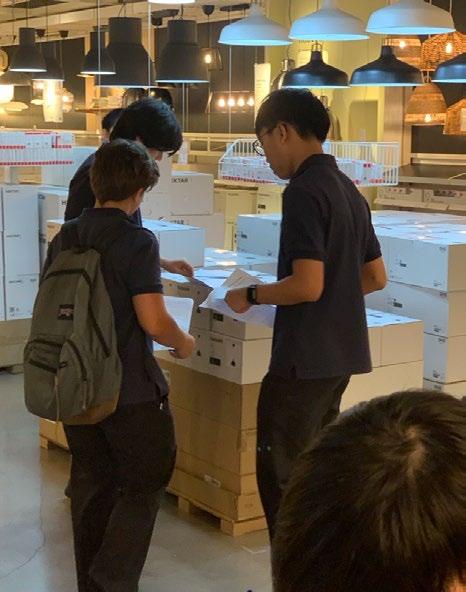



was founded on our belief in an equal healthcare system that doesn’t marginalise underrepresented victims. Alzheimers is a poignant example of an underrepresented disease in society. Many aren’t aware of its existence and those that are, don’t truly grasp the severity of what it means to ‘forget’. Many students have grandparents, uncles or even parents who are approaching the age where Alzheimer’s can start affecting their well-being. It is of utmost importance that they are prepared to encounter and empathize with their loved ones in the unfortunate circumstance that the disease befalls them. Thus, as a student organization, DATA is in a position to raise awareness toward these younger generations while also generating revenue through fundraising to directly support nursing homes and research into the disease.
In the beginning, it was immensely difficult to establish DATA as a functioning student organisation as we started from just a few core members. However, we feel immensely proud of the progress that we have been able to make since its initiation. From meticulously planned milestones to recruiting dedicated members, we formed a profound camaraderie among members that fueled various collaborations. These collaborations include brands such as The Rolling Pinn, where we fundraised through bake sales, directly negotiating donations and discounts with the brand and Chulalongkorn’s Red Cross Dementia project, where we directly supported victims of Dementia and Alzheimer’s disease through donation.
These collaborations were manifested through our stalls, hosted by various school events. For example, the Christmas concerts brought students and parents together to celebrate school culture, where our desserts supplemented the festive atmosphere perfectly. Moreover, targeting parents in the school community allowed us to receive direct donations from those who are also impacted by Alzheimer’s disease. This became our core marketing strategy that allowed us to raise funds in the tens of thousands of baht. In terms of raising awareness, our stalls during the Community Engagement Fairs involved immersive auditory experiences that allowed students and teachers to immerse themselves in what it ‘sounds’ like to have Dementia. The response from this stall was immensely vocal and positive, evoking a serious and contemplative atmosphere which contrasts the usual festivity of the impact fair.
As we transition to university, we are delighted to hand over the club to its next leaders, whom we have nurtured
and trained on our core values. As society progresses, so do the ways in which a socially conscious club is run and managed. Social media and digitalisation could be the next frontier in spreading awareness and generating funds through e-commerce. These future goals will be at the cornerstone of the new leadership’s direction in furthering the goals of our organisation. Overall, despite a majority of our core members transitioning to university, there is immense optimism for the future of DATA and its operation.

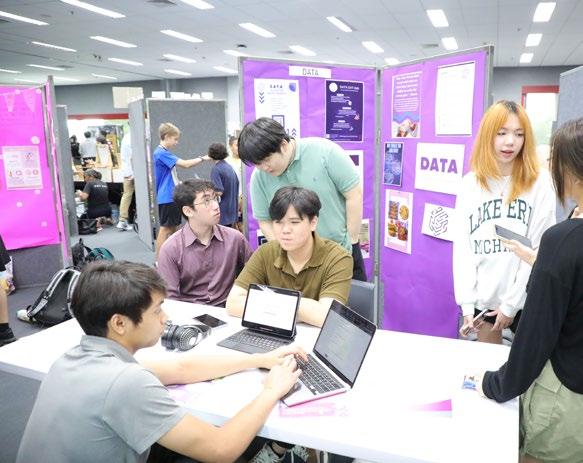
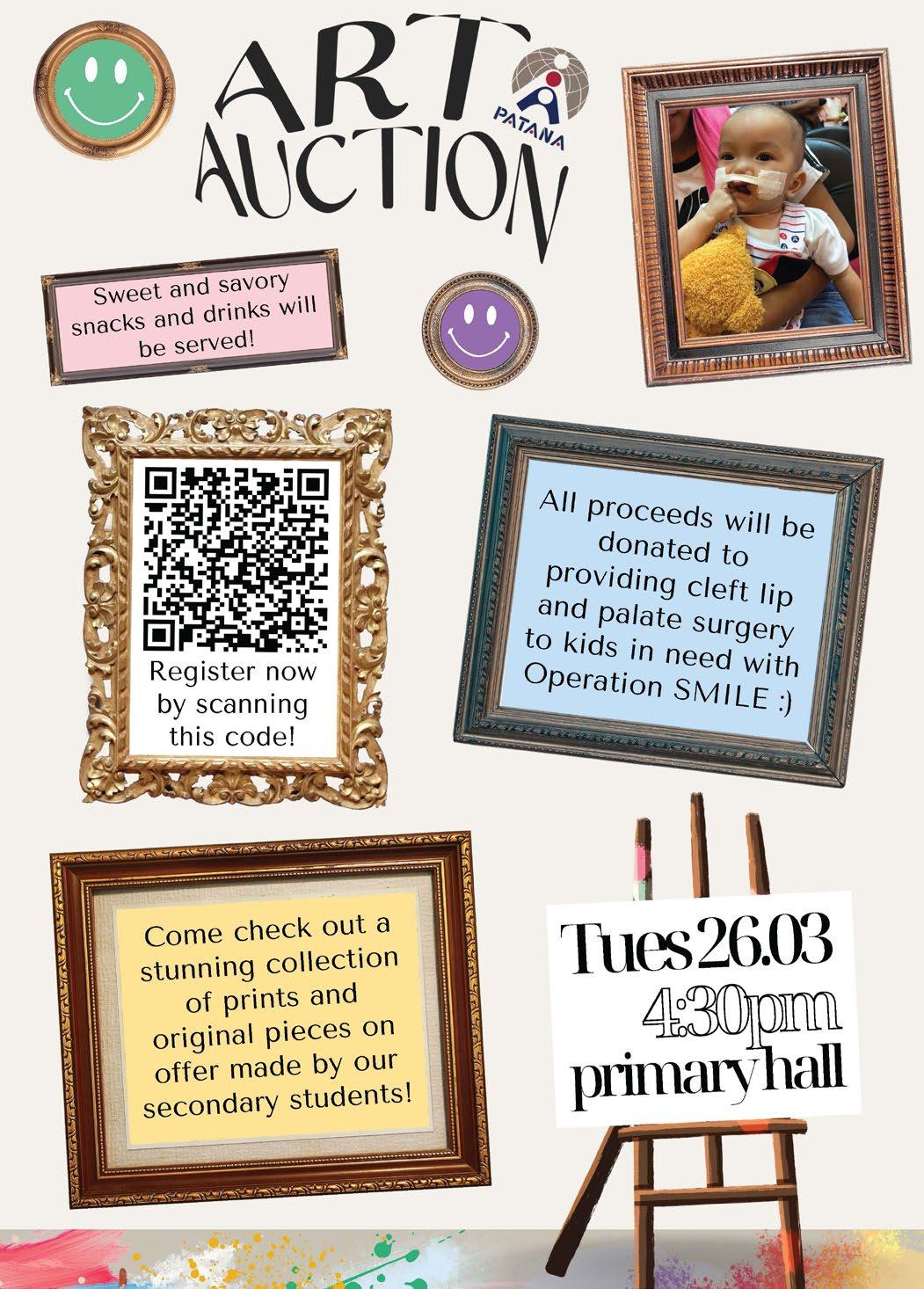

After a successful Junior FOBISIA event, last weekend saw the Secondary students in action again in the seaside resort of Hua Hin. Unlike the Junior event which had the vast majority of entrants from Thailand, this event had a real international flavour to it with schools from Singapore, Philippines, Malaysia, Taiwan, Kazakhstan and Brunei taking part.
With 165 competitors across the six events - three for boys and three for girls matches started at 7:00 am and on the first two days finished at 7:00 pm with the 10 courts occupied throughout. All age groups were initially split into a round robin group stage with group winners and in
some age groups best runners up qualifying for the quarter finals. The 29 Bangkok Patana students all competed well winning many matches and more importantly gaining valuable experience against in some cases highly ranked National players and to their credit 12 players qualified for the last eight rounds.
Sunday saw all the knockout stages take place and although the 12 players became four, whilst others came very close to reaching the semi finals.
Al (Boys U15), Rinka (Girls U15) and Asama ( Girls Over 15) all won their bronze medal matches to finish 3rd whilst Amy finished 4th in the Girls over 15.






Of the 1100+ species of birds in Thailand, I think it is safe to say that the birds that people see first (aside from house sparrows, common myna and crows…) are members of the family Ardeidae – the egrets, herons and bitterns. The egrets in particular, due to their striking pure white plumage, stand out in any habitat and are often noticed by people who have no interest in birds at all.
As an avid wildlife watcher myself, I often have people tell me about the lovely ‘cranes’ they’ve seen in the rice fields of Thailand. Often when with friends or students, I often hear, “Look at those cranes over there!” Well, while there is a species of crane in Thailand, one would have to be extremely lucky to see them in their natural habitat, which is primarily in Buriram Province where there is a slowly recovering population of Eastern Sarus Crane which was nearly extinct until recent recovery efforts.
There are 18 species of Ardeids in Thailand, and many are very easy to see. Great, intermediate and little egrets are often found together in rice fields in and around town. The best way to distinguish between the species is to get a good bird guide (I recommend Birds of Thailand by Treesucon & Limparungpatthanakij) and learn the field di-
agnostics. Eastern cattle egrets are also common in and around town. Javan and Chinese Pond Herons are also very commonly seen locally but they can only be realistically distinguished from each other when they are in breeding plumage. Striated or Little Herons are common as well but tend to be a bit shy and easily spooked. The true beauties in the group are the large grey and purple herons which are incredibly beautiful and graceful in flight. While they are still fairly common, their habitat is rapidly disappearing. One species I have a particular fondness of is the Pacific Reef Heron which is a constant neighbour of mine at my home in Koh Lanta.
The rarities in the group include the elusive cinnamon and black bitterns which take a bit of effort and luck to see in the wild. Even more so is the rare Malayan night heron which I have only seen once since moving to Thailand. The far more common black-crowned night heron is readily seen in good numbers in many wetlands in Thailand such as Bueng Boraphet in Nakhon Sawan or Thale Noi in the south.
Most of the Ardeids are year-round residents and can be a great way to spark a passion for birdwatching.


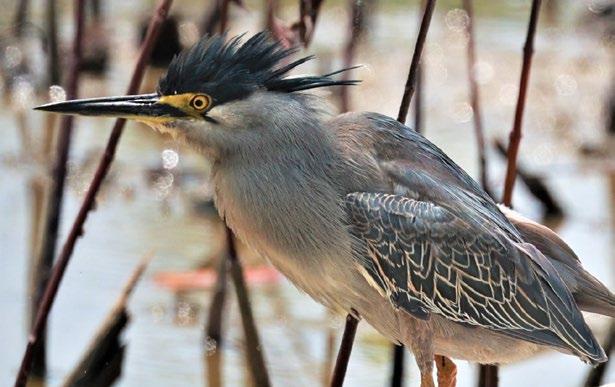

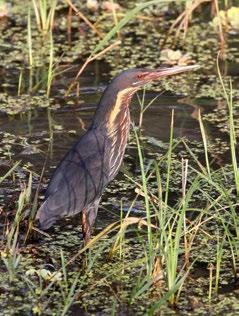






University admission has been in the news in several countries over the last few months. In our most recent university coffee morning, we examined some of the trends and topics which could be causing concern or confusion in several of Bangkok Patana’s most popular university destinations. Over the next few weeks, I’ll be covering these changes and providing updates to the wider parent community since our most recent presentation.
Dutch universities at all levels became a hub for English-language post-secondary education over the last several years by offering a wide variety of English-language courses, reasonable admissions requirements for IB diploma holders and EU tuition rates for EU passport holders. This interest only increased following Brexit, when the UK stopped offering home status for EU residents. For these and other reasons, the Netherlands became a very popular destination for students around the world. While this has been great for students hoping to study in English at a European university, Dutch officials have been concerned at the loss of Dutch language fluency within the nation’s commerce, which ultimately led to these changes.
In February 2024, Dutch universities and the Dutch government made an announcement which changed the landscape completely. Incoming students will be required to take Dutch language and culture courses, no new English courses will be developed, admission will become much more selective and Dutch universities will no longer be travelling to overseas recruitment events, including the annual Bangkok Patana university fair. The timing of these new regulations has yet to be set, but we anticipate Grad’25 will begin to see the effects of these changes.
students have access to English-language courses at institutions which best fit their needs. We are here to work with students and their families as they navigate these changes.

The most concerning part of these changes is the increasing selectivity of the English-language courses. Our students, especially EU citizens hoping to study in English and pay EU fees, will need to cast a wider net and look for other English-language courses in other parts of Europe. Ireland, with their fabulous universities offering very highly regarded degrees, would be an obvious solution, but they do not offer EU fees for EU citizens who have resided outside the EU immediately prior to enrolment. There are certainly a wealth of English-language courses available in many countries in Europe but no other country currently has such a variety of quality programs. The Careers team already has established relationships with universities across Europe and will continue to ensure our
One benefit of the new changes is the liberalisation of the immigration laws for graduates of Dutch universities. The government has committed to easing the paths to residency and citizenship for new graduates who decide to stay in the Netherlands. This, along with an enriched cultural experience offered by the Dutch language and culture courses will certainly keep the Netherlands as a serious option for our students well into the future.
Next week, I’ll take a look at the return of the SAT testing requirement in the United States and how universities have decided to implement or permanently avoid testing in their admission processes.



Thailand’s tropical climate is a fantastic backdrop for sports and outdoor activities, but it also comes with the challenge of intense heat and humidity. As dedicated athletes, it’s essential to know how to protect ourselves from the scorching sun to ensure both performance and safety. The Student Athletic Council is here to provide you with strategies to beat the heat and stay sun smart.
In Thailand’s sweltering heat, you lose fluids rapidly through sweat. Staying well-hydrated is the cornerstone of heat safety. Always carry a reusable water bottle and drink water consistently, even if you don’t feel thirsty. Sports drinks with electrolytes can also help replace lost minerals during intense activities.
Wearing appropriate clothing is essential in the heat. Opt for lightweight, loose-fitting, and breathable fabrics like moisture-wicking materials that draw sweat away from your skin. We highly recommend you wear a hat whenever outside and sunglasses to shield your face and eyes from the sun.
Sunscreen is your armour against harmful UV rays. Choose a broad-spectrum sunscreen with a high SPF rating, and apply it generously to all exposed skin, including your face, neck, and ears. Reapply regularly, especially if you’re sweating heavily.
Plan your outdoor activities during the cooler parts of

the day, such as early morning or late afternoon. Avoid the midday sun when the heat is at its peak, and the risk of sunburn and heat-related illnesses is highest.
During training or games, remember to take regular breaks in the shade to cool down and rehydrate. Overexertion in the heat can lead to heat exhaustion and heat stroke, which are severe conditions.

Know the signs of heat-related illnesses, including heat exhaustion and heat stroke. Symptoms can include heavy sweating, weakness, dizziness, nausea, confusion, and high body temperature. If you or a teammate experience these symptoms, seek immediate help from your Coach/ Teacher and/or the School Nursing staff.
Look out for your teammates and encourage each other to stay sun smart and safe. Create a culture of responsibility and awareness within your sports team.
Your body is your best indicator. If you feel excessively hot, dizzy, or unwell, don’t push yourself too hard. Stop, rest, and cool down.


Just enough time to squeeze in two tech tips in three minutes for you this week…

Timestamps
0:00 #1 Parent reviews on TV shows, Movies, Games, Books etc on Common Sense Media app
1:20 #2 How to subscribe to the school calendar on your Android device
Have a fantastic weekend.
Brian Taylor Assistant Principal, Technology for Learning
